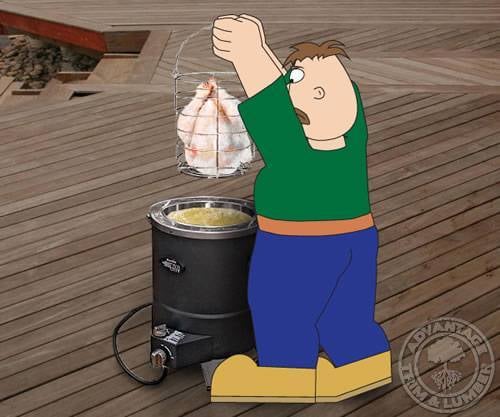It’s become increasingly popular to deep fry turkeys instead of baking them. It cooks the bird quickly and retains much of the juice normally dried up by baking. But deep frying is also a very dangerous method if not done correctly.
Take a look at these videos and how dangerous frying a turkey can be:
If you choose to deep fry your turkey this Thanksgiving, make sure to:
- Thaw the turkey first. A frozen bird will cause an explosion when submerged in boiling oil.
- Set up your deep fryer outside, not on your deck. Not only will oil spills create a hard-to-clean mess, but you could also set your deck on fire.
- Use a smaller turkey, or break a large bird into smaller chunks and fry them in batches. Larger turkeys take longer to cook, which can overexpose the skin. If you purchase a large bird (over 15 pounds), it’s recommended to split it by dark meat and light meat.
Many specialized turkey fryers feature a fill line telling you how much oil to pour into the pot. If your deep fryer lacks this, you can calculate your own fill line by placing the turkey into the empty fryer and filling it with water until the bird is completely submerged.
Remove the turkey, allowing it to drain back into the pot, then measure the distance from the top of the pot to the water level. That’s your fill line. When you’re done, make sure to drain your fryer thoroughly. If your fryer has a drain spigot, make sure there’s no excess water hiding in there.
Next, fill the pot with oil and preheat it to 375–400°F. While it heats, you can move on to preparing your turkey.
Be sure to save the wrapper when you take out your turkey. The wrapper will tell you how much the bird weighs, which determines how long you need to fry it. To prepare the turkey for frying:
- Thaw it completely.
- Remove the neck and giblets.
- If your turkey came with trusses holding the legs in place or a popup thermometer, remove them.
- Remove the tail and cut off the wing tips up to the first joint.
- Remove excess fat around the neck so oil can flow freely through the bird.
- Completely dry the interior and exterior of the bird. This will reduce splattering when you drop it in the deep fryer.
- Marinade and season as desired. Don’t inject marinades too close to the skin surface, as that will result in popping and splattering.
- Let the turkey sit in a baking pan for no more than 45 minutes. This raises the bird’s temperature, again reducing splattering during the frying process.
When it’s time to actually fry your turkey, lower the meat into the oil slowly. This will prevent dangerous splashes. For whole turkeys, cook 3–4 minutes per pound. If you split your turkey into pieces, allow 4–5 minutes per pound. Internal meat temperature should be 165–170°F for breast meat and 175–180°F for the thighs.
Throughout the cooking process, never leave the deep fryer unattended, and keep children and pets away from the cooking area at all times. When you’re done, allow the oil to cool before disposal or storage. Remember, raw turkey is poisonous, so anything that comes into contact with raw meat must be washed immediately.
